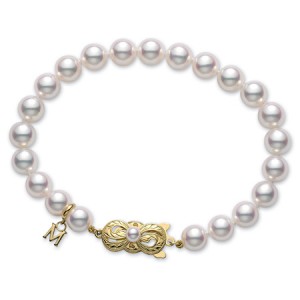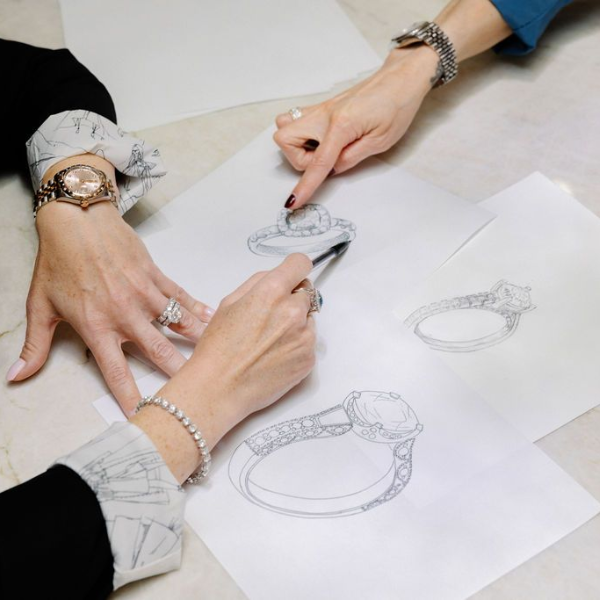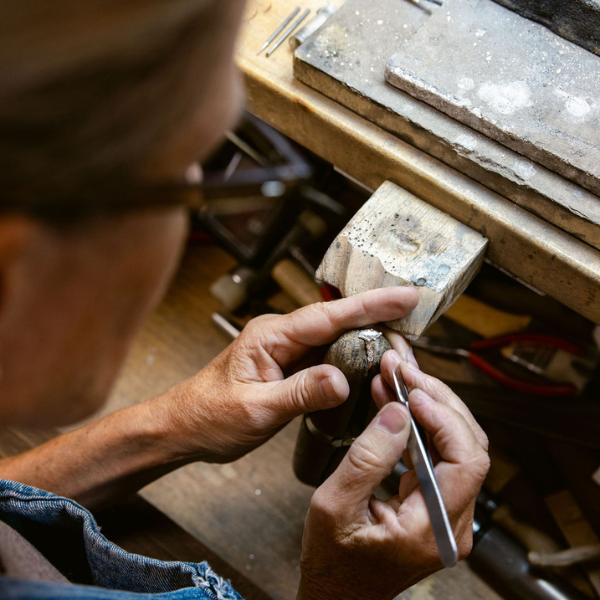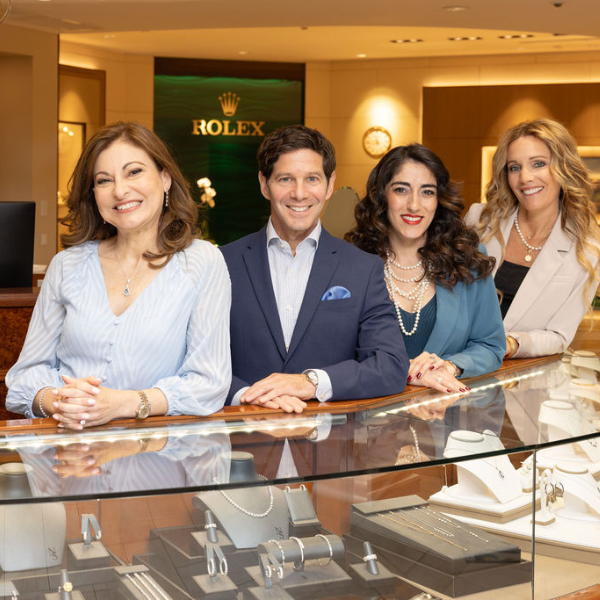 A classic white Akoya strand of pearls from Mikimoto. Available at Roman Jewelers Many of us know have heard about the “4Cs” of diamonds, but what about Pearls? There is quite a bit to know without any acronyms to help us remember… Lustre The combination of surface brilliance and a deep-seated glow, the luster of a good-quality cultured pearl should be bright, not dull. Your reflection should be seen clearly on the surface of a cultured pearl. Any pearl that looks too chalky or dull indicates low quality. Surface Cleanliness of the cultured pearl surface refers to the absence of disfiguring spots, bumps or cracks. A cultured pearl with a clean surface will have a higher value than a spotted, bumpy or cracked one. Shape Since cultured pearls are grown by oysters and subject to the whims of Mother Nature, it is very rare to find a perfectly round cultured pearl. While rounder pearls are more valuable, asymmetrical, or baroque, pearls have a unique charm and are available at a more moderate cost. Color Rose Silver/White Cream Gold Blue/Gray cultured pearls occur in colors from rosé to black. Color is a matter of preference and budget. Size Measured by their diameter in millimeters, the average cultured pearls sold today are between 7 and 7 1/2 millimeters. Generally, the larger the pearl, the more valuable it will be. There are also many varieties of pearls, which relates to where they are created: Akoya (grown in Japan and China) Akoya pearls are the classic cultured pearls of Japan. They are the most lustrous of all pearls found anywhere in the world. In recent years, China has been successful in producing Akoya pearls within their own waters. However, at this time they are unable to produce as brilliant a lustre as high quality Japanese Akoya cultured pearls. White South Sea (grown in Australia, Mynamar and Indonesia) White South Sea cultured pearls are grown in large tropical or semi-tropical oysters in Australia, Mynamar, Indonesia and other Pacific countries. They generally range in size from 10mm to 20mm and command premium prices because of their relative rarity and large size. South Sea Black (grown in French Polynesia) South Sea black cultured pearls are grown in a variety of large pearl oysters found primarily in French Polynesia. Their beautiful, unique color and large size can command very high prices. Freshwater (grown in Japan, China and the United States) Freshwater cultured pearls are easily cultivated from freshwater mussels rather than saltwater oysters. They are produced in great abundance, and are therefore generally the most moderately priced of all cultured pearl varieties. Their unique shapes and gentle pastel colors make them perfect gems for those on a budget. Mabe Pearls (grown in Japan, Australia, French Polynesia, Indonesia, and the Philippines) Mabe cultured pearls are hemispherical pearls grown against the inside shell of any oyster rather than within the oyster's body. They are generally used in ring, earring and pendant settings which cover their flat backs or reverse side. Keshi Pearls (grown in Japan, Australia, French Polynesia, Indonesia, and the Philippines) Keshi cultured pearls, though not nucleated pearls, are created by accident as a result of the sulturing process and these must be considered cultured pearls. Their unusual shapes and sizes are best used in unique jewelry designs. Thank you to the Jewelry Information Center for this content.
A classic white Akoya strand of pearls from Mikimoto. Available at Roman Jewelers Many of us know have heard about the “4Cs” of diamonds, but what about Pearls? There is quite a bit to know without any acronyms to help us remember… Lustre The combination of surface brilliance and a deep-seated glow, the luster of a good-quality cultured pearl should be bright, not dull. Your reflection should be seen clearly on the surface of a cultured pearl. Any pearl that looks too chalky or dull indicates low quality. Surface Cleanliness of the cultured pearl surface refers to the absence of disfiguring spots, bumps or cracks. A cultured pearl with a clean surface will have a higher value than a spotted, bumpy or cracked one. Shape Since cultured pearls are grown by oysters and subject to the whims of Mother Nature, it is very rare to find a perfectly round cultured pearl. While rounder pearls are more valuable, asymmetrical, or baroque, pearls have a unique charm and are available at a more moderate cost. Color Rose Silver/White Cream Gold Blue/Gray cultured pearls occur in colors from rosé to black. Color is a matter of preference and budget. Size Measured by their diameter in millimeters, the average cultured pearls sold today are between 7 and 7 1/2 millimeters. Generally, the larger the pearl, the more valuable it will be. There are also many varieties of pearls, which relates to where they are created: Akoya (grown in Japan and China) Akoya pearls are the classic cultured pearls of Japan. They are the most lustrous of all pearls found anywhere in the world. In recent years, China has been successful in producing Akoya pearls within their own waters. However, at this time they are unable to produce as brilliant a lustre as high quality Japanese Akoya cultured pearls. White South Sea (grown in Australia, Mynamar and Indonesia) White South Sea cultured pearls are grown in large tropical or semi-tropical oysters in Australia, Mynamar, Indonesia and other Pacific countries. They generally range in size from 10mm to 20mm and command premium prices because of their relative rarity and large size. South Sea Black (grown in French Polynesia) South Sea black cultured pearls are grown in a variety of large pearl oysters found primarily in French Polynesia. Their beautiful, unique color and large size can command very high prices. Freshwater (grown in Japan, China and the United States) Freshwater cultured pearls are easily cultivated from freshwater mussels rather than saltwater oysters. They are produced in great abundance, and are therefore generally the most moderately priced of all cultured pearl varieties. Their unique shapes and gentle pastel colors make them perfect gems for those on a budget. Mabe Pearls (grown in Japan, Australia, French Polynesia, Indonesia, and the Philippines) Mabe cultured pearls are hemispherical pearls grown against the inside shell of any oyster rather than within the oyster's body. They are generally used in ring, earring and pendant settings which cover their flat backs or reverse side. Keshi Pearls (grown in Japan, Australia, French Polynesia, Indonesia, and the Philippines) Keshi cultured pearls, though not nucleated pearls, are created by accident as a result of the sulturing process and these must be considered cultured pearls. Their unusual shapes and sizes are best used in unique jewelry designs. Thank you to the Jewelry Information Center for this content.June's Birthstone Is Pearl! Want To Know More?
By: Admin
Jun 01,2015
 A classic white Akoya strand of pearls from Mikimoto. Available at Roman Jewelers Many of us know have heard about the “4Cs” of diamonds, but what about Pearls? There is quite a bit to know without any acronyms to help us remember… Lustre The combination of surface brilliance and a deep-seated glow, the luster of a good-quality cultured pearl should be bright, not dull. Your reflection should be seen clearly on the surface of a cultured pearl. Any pearl that looks too chalky or dull indicates low quality. Surface Cleanliness of the cultured pearl surface refers to the absence of disfiguring spots, bumps or cracks. A cultured pearl with a clean surface will have a higher value than a spotted, bumpy or cracked one. Shape Since cultured pearls are grown by oysters and subject to the whims of Mother Nature, it is very rare to find a perfectly round cultured pearl. While rounder pearls are more valuable, asymmetrical, or baroque, pearls have a unique charm and are available at a more moderate cost. Color Rose Silver/White Cream Gold Blue/Gray cultured pearls occur in colors from rosé to black. Color is a matter of preference and budget. Size Measured by their diameter in millimeters, the average cultured pearls sold today are between 7 and 7 1/2 millimeters. Generally, the larger the pearl, the more valuable it will be. There are also many varieties of pearls, which relates to where they are created: Akoya (grown in Japan and China) Akoya pearls are the classic cultured pearls of Japan. They are the most lustrous of all pearls found anywhere in the world. In recent years, China has been successful in producing Akoya pearls within their own waters. However, at this time they are unable to produce as brilliant a lustre as high quality Japanese Akoya cultured pearls. White South Sea (grown in Australia, Mynamar and Indonesia) White South Sea cultured pearls are grown in large tropical or semi-tropical oysters in Australia, Mynamar, Indonesia and other Pacific countries. They generally range in size from 10mm to 20mm and command premium prices because of their relative rarity and large size. South Sea Black (grown in French Polynesia) South Sea black cultured pearls are grown in a variety of large pearl oysters found primarily in French Polynesia. Their beautiful, unique color and large size can command very high prices. Freshwater (grown in Japan, China and the United States) Freshwater cultured pearls are easily cultivated from freshwater mussels rather than saltwater oysters. They are produced in great abundance, and are therefore generally the most moderately priced of all cultured pearl varieties. Their unique shapes and gentle pastel colors make them perfect gems for those on a budget. Mabe Pearls (grown in Japan, Australia, French Polynesia, Indonesia, and the Philippines) Mabe cultured pearls are hemispherical pearls grown against the inside shell of any oyster rather than within the oyster's body. They are generally used in ring, earring and pendant settings which cover their flat backs or reverse side. Keshi Pearls (grown in Japan, Australia, French Polynesia, Indonesia, and the Philippines) Keshi cultured pearls, though not nucleated pearls, are created by accident as a result of the sulturing process and these must be considered cultured pearls. Their unusual shapes and sizes are best used in unique jewelry designs. Thank you to the Jewelry Information Center for this content.
A classic white Akoya strand of pearls from Mikimoto. Available at Roman Jewelers Many of us know have heard about the “4Cs” of diamonds, but what about Pearls? There is quite a bit to know without any acronyms to help us remember… Lustre The combination of surface brilliance and a deep-seated glow, the luster of a good-quality cultured pearl should be bright, not dull. Your reflection should be seen clearly on the surface of a cultured pearl. Any pearl that looks too chalky or dull indicates low quality. Surface Cleanliness of the cultured pearl surface refers to the absence of disfiguring spots, bumps or cracks. A cultured pearl with a clean surface will have a higher value than a spotted, bumpy or cracked one. Shape Since cultured pearls are grown by oysters and subject to the whims of Mother Nature, it is very rare to find a perfectly round cultured pearl. While rounder pearls are more valuable, asymmetrical, or baroque, pearls have a unique charm and are available at a more moderate cost. Color Rose Silver/White Cream Gold Blue/Gray cultured pearls occur in colors from rosé to black. Color is a matter of preference and budget. Size Measured by their diameter in millimeters, the average cultured pearls sold today are between 7 and 7 1/2 millimeters. Generally, the larger the pearl, the more valuable it will be. There are also many varieties of pearls, which relates to where they are created: Akoya (grown in Japan and China) Akoya pearls are the classic cultured pearls of Japan. They are the most lustrous of all pearls found anywhere in the world. In recent years, China has been successful in producing Akoya pearls within their own waters. However, at this time they are unable to produce as brilliant a lustre as high quality Japanese Akoya cultured pearls. White South Sea (grown in Australia, Mynamar and Indonesia) White South Sea cultured pearls are grown in large tropical or semi-tropical oysters in Australia, Mynamar, Indonesia and other Pacific countries. They generally range in size from 10mm to 20mm and command premium prices because of their relative rarity and large size. South Sea Black (grown in French Polynesia) South Sea black cultured pearls are grown in a variety of large pearl oysters found primarily in French Polynesia. Their beautiful, unique color and large size can command very high prices. Freshwater (grown in Japan, China and the United States) Freshwater cultured pearls are easily cultivated from freshwater mussels rather than saltwater oysters. They are produced in great abundance, and are therefore generally the most moderately priced of all cultured pearl varieties. Their unique shapes and gentle pastel colors make them perfect gems for those on a budget. Mabe Pearls (grown in Japan, Australia, French Polynesia, Indonesia, and the Philippines) Mabe cultured pearls are hemispherical pearls grown against the inside shell of any oyster rather than within the oyster's body. They are generally used in ring, earring and pendant settings which cover their flat backs or reverse side. Keshi Pearls (grown in Japan, Australia, French Polynesia, Indonesia, and the Philippines) Keshi cultured pearls, though not nucleated pearls, are created by accident as a result of the sulturing process and these must be considered cultured pearls. Their unusual shapes and sizes are best used in unique jewelry designs. Thank you to the Jewelry Information Center for this content.





















































